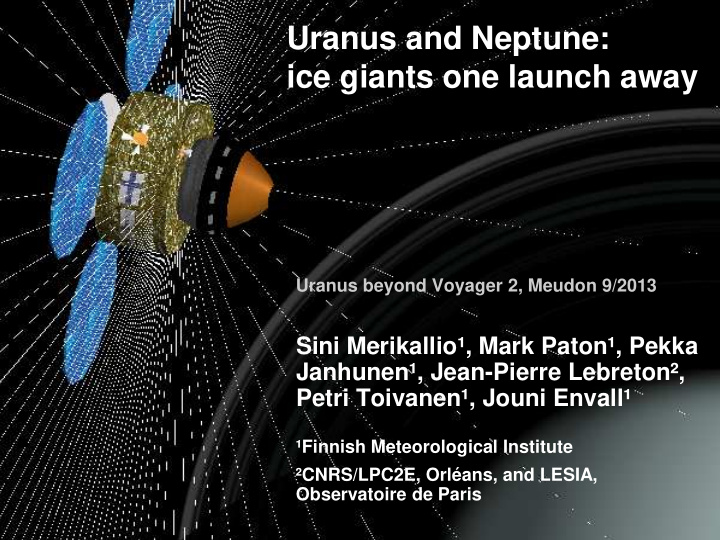



Uranus and Neptune: ice giants one launch away Uranus beyond Voyager 2, Meudon 9/2013 Sini Merikallio¹, Mark Paton¹, Pekka Janhunen¹, Jean-Pierre Lebreton², Petri Toivanen¹, Jouni Envall¹ ¹Finnish Meteorological Institute ²CNRS/LPC2E, Orléans, and LESIA, Observatoire de Paris
Traditional approach
Electric Solar Wind Sail (E-sail) 100 - 200 kg 1 N, 700 W @ 1 au Thrust ~1/ r Power consumption ~1/ r² Flexible launches: - No need for gravity assists - Any escape orbit is good piggyback opportunities www.electric-sailing.fi
Uranus (19 au) Assumed E-sail: • 0.5 N thrust at 1 au, • mass 100 kg Total mass Total minus E-sail Travel time Entry Speed 300 kg 200 kg 3.1 yr. 36 km/s 550 kg 450 kg 5.3 yr. 25 km/s 800 kg 700 kg 9.6 yr. 20 km/s www.electric-sailing.fi
Neptune (30 au) E-sail: 0.5 N @ 1 au, 100 kg Total mass Total minus Travel time Entry E-sail Speed 300 kg 200 kg 4.6 yr. 38 km/s 550 kg 450 kg 8.0 yr. 28 km/s 800 kg 700 kg 14.9 yr. 23 km/s www.electric-sailing.fi
Mariner Jupiter/Uranus 1979 mission with Uranus Entry Probe (1974) JPL Space Science Board Summer Study
Trajectory model • 3 degrees-of-freedom numerical trajectory simulation • Rotation of the atmosphere and winds • Polytropic atmosphere model for Uranus • Includes guidance routines for lifting bodies 2-DoF version: Paton, M. and Schmidt, W. (2007): Atmospheric modelling for realistic EDL scenarios, 5 th International Planetary Probe Workshop, 23-29 June, Bordeaux, France
Heat loads g > Galileo Galileo 40 km/s retrograde 40 km/s prograde 30 km/s retrograde 30 km/s prograde
Entry probe mission, 5.3 years travel time Total in escape orbit 550 kg: • 0.5 N E-sail 100 kg • Carrier & Relay S/C 150 kg wet: - Orbit corrections fuel 35 kg (0.2 km/s ∆v ) - Dry mass 115 kg • Entry probe 300 kg, 27.5 km/s prograde: - Heat shield 90 kg - Bus 175 kg Instrument fraction assumed same as - Instruments 35 kg in Galileo probe
Orbiter mission, 9.6 years travel time Total in escape orbit 800 kg: • 0.5 N E-sail 100 kg • Orbit insertion fuel 290 kg (1.8 km/s ∆ v) • Manoeuvre fuel 62 kg (0.3 km/s ∆ v) • Dry mass 348 kg: - Bus 313 kg (90% of orbiter dry) - Instruments 35 kg (10% of orbiter dry)
Conclusions Enabled by 0.5 N E-sail: • 35 kg of entry probe instruments in 5.3 years • 350 kg orbiter (dry mass) in 9.6 years • Flexible launches 1 N E-sail is goal, 0.5 N is conservative www.electric-sailing.fi
Recommend
More recommend